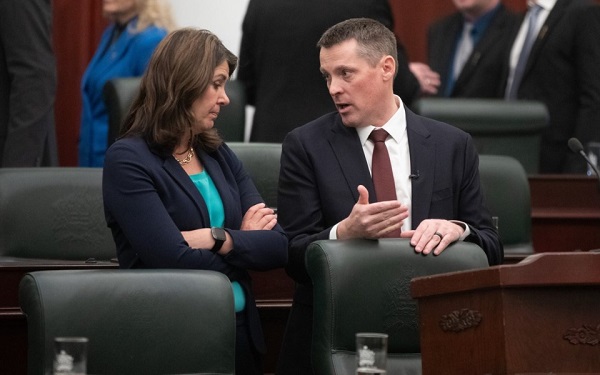Alberta
Provincial Budget 2025: Meeting the challenge

To help Albertans with the high cost of living, Budget 2025 delivers on the promised tax cut that will save Albertans hundreds of dollars starting this year. The new eight per cent personal income tax bracket for income up to $60,000 is starting two years ahead of schedule and will save Albertan families up to $1,500 in 2025.
To meet the needs of a population that has grown rapidly in the last few years, Budget 2025 also makes the highest-ever investment in health care and education while moving forward with the Alberta government’s commitment to build schools and classroom spaces faster. The budget continues to support vulnerable Albertans and keep communities and provincial borders safe while supporting the economy, communities and sectors outside the oil and gas industry.
“Budget 2025 is a budget of tough but measured choices that meet the needs of Albertans and maintains our Alberta advantage. It cuts taxes, steadfastly supports public services and solidifies our economic foundation so it can withstand future headwinds.”
Budget 2025 takes a cautious approach in its economic outlook, reflecting the high risk of a Canada-U.S. trade conflict and the potential significant impact on the Alberta economy. The outlook assumes a moderate trade conflict where Canada will face an average 15 per cent tariffs on all goods, while energy products will face a 10 per cent tariff. Alberta will continue to work with federal, provincial and territorial partners to find solutions. Even in light of tariffs, the province expects moderate but continued growth in oil production and investment to keep the province’s economic engine humming. Alberta’s responsible crude oil exports are expected to continue to meet critical U.S energy needs, and the Trans Mountain Pipeline expansion will provide more export capacity for producers.
Investment will continue in existing major projects that are driving activity in industrial building construction, including Dow’s Path2Zero project, Air Products’ new hydrogen facility and Imperial Oil’s Strathcona Refinery renewable diesel expansion project.
Alberta’s housing market is expected to stand out as a bright spot in the economy as homebuilders work to meet the needs of a growing population A slower population growth will help the labour market gradually rebalance over the next few years.
While the province is facing significant economic uncertainty and revenue volatility, the government remains committed to making prudent spending decisions to keep operating expense growth below population growth plus inflation and to sustainably deliver important programs and services to Albertans and Alberta businesses.
Budget 2025 invests:
- $9.9 billion in operating expenses for education, an increase of 4.5 per cent from 2024-25, to help with enrolment pressures, hire more teachers and other educational staff, and support complex classrooms and students.
- $2.6 billion over three years for educational (K-12) infrastructure, an increase of $505 million or 23.9 per cent from Budget 2024. This funding will support the construction of more than 200,000 new and modernized student spaces over the next seven years (almost 90,000 within the next four years).
- $28 billion in operating expense, an increase of $1.4 billion or 5.4 per cent, across the refocused health care system including:
- $22.1 billion to health care to improve access to quality health services close to home, prioritize patients, build capacity at hospitals and rural facilities, expand surgeries and compensate and retain health professionals.
- $1.7 billion for implementing the compassionate intervention framework and Recovery Alberta Services.
- $3.8 billion to focus on making the full continuum of care available to all Albertans, from assisted living, home care and community care, to housing and social supports with wraparound social services.
- $1.3 billion for operating expense for Public Safety and Emergency Services, an increase of 3.7 per cent from 2024-25, to support Alberta Sheriffs, Correctional Services and emergency management in the work to keep Alberta communities safe and secure the southern border.
- $1.6 billion, or a six per cent increase from last year, for Children and Family Services to strengthen the programs vulnerable children and families rely on.
- $6.2 billion, or an 8.8 per cent increase from 2024-25, to support core social programs, including a short-term bump to support more people affected by potential U.S. tariffs and rising grants for housing programs.
- Overall, Budget 2025’s Capital Plan includes $26.1 billion over three years, an increase of 4.4 per cent or $1.1 billion more than Budget 2024, to meet the challenge of growth and build and enhance schools, hospitals, roads and bridges in the province. The plan is projected to support an average of 26,500 direct and 12,000 indirect jobs annually through 2027-28.
The province is also continuing to focus on building the Heritage Fund to $250 billion by 2050. The fund was valued at $25 billion in the third fiscal quarter of 2024-25 and is expected to grow to about $27 billion by the end of the fiscal year. A renewed Heritage Fund that earns money year over year will secure a resilient and prosperous Alberta for generations to come and lessen the province’s reliance on natural resource revenues. An independent board of directors and a new Heritage Fund Opportunities Corporation will unlock access to new opportunities and partnerships with global sovereign wealth funds.
Revenue
- Total revenue in 2025-26 is forecast at $74.1 billion, a decrease of $6.6 billion from the 2024-25 forecast of $80.7 billion. Total revenue is forecast to grow to $77.4 billion in 2026-27 and $80 billion by 2027-28, with broad-based revenue growth led primarily by income taxes.
- The decrease in 2025-26 comes mainly from a $4.4 billion drop in non-renewable resource revenue, driven by an anticipated decline in oil prices. This revenue source is forecast at $17.1 billion in 2025-26, compared to the $21.5 billion forecast for 2024-25.
- Revenue from personal income taxes is estimated to decrease to $15.5 billion in 2025-26, down from the $16.1 billion at the third quarter, due to the new eight per cent income tax bracket and negative impacts associated with potential tariffs. Personal income tax revenue is forecast to grow moderately in the following two years as more people continue to move to Alberta.
- Corporate income tax revenue is estimated at $6.8 billion in 2025-26, down $586 million from the third-quarter forecast for 2024-25, but rising over the next two years.
Expense
- Total expense in 2025-26 is forecast at $79.3 billion, an increase of $4.4 billion or 5.9 per cent from the 2024-25 third quarter forecast.
- Total expense is expected to be $79.8 billion in 2026-27 and $82 billion in 2027-28, or an increase of about 1.7 per cent per year.
- Operating expense is estimated at $64.3 billion, an increase of $2.2 billion or 3.6 per cent from the 2024-25 third quarter forecast.
- Operating expense grows to $64.8 billion in 2026-27 and $66.5 billion in 2027-28, an average increase of 1.7 per cent per year.
- A contingency of $4 billion will help to provide government with more flexibility to address unforeseen implications of increased economic uncertainty as well as compensation expense for collective bargaining currently underway.
Deficit
- A deficit of $5.2 billion is forecast for 2025-26.
- The deficit is forecast to drop to $2.4 billion and $2 billion for 2026-27 and 2027-28, respectively.
- The government’s fiscal framework includes allowable exceptions for when the government can run a deficit, including when there is a significant drop in revenue.
- This deficit is largely the result of falling non-renewable resource revenues and increases in costs necessary to provide world-class services to Albertans.
Debt
- Debt servicing costs are forecast to decrease by $231 million in 2025-26 from the 2024-25 forecast, to $3 billion, as funds pre-borrowed in 2024-25 will be used to repay sizeable debt maturities coming due in early 2025-26.
Economic Outlook
- In 2025, real gross domestic product is expected to decelerate to 1.8 per cent, then 1.7 per cent in 2026.
- Population growth is expected to moderate, growing at 2.5 per cent in the 2025 census year, down from the record 4.4 per cent growth in 2024. Growth will shift down to 1.4 per cent over the following two years, then 1.6 per cent in 2028.
Energy and economic assumptions, 2025-26
- West Texas Intermediate oil (USD/bbl) $68
- Western Canadian Select @ Hardisty (CND/bbl) $73.10
- Light-heavy differential (USD/bbl) $17.10
- ARP natural gas (CND/GJ) $2.50
- Conventional crude production (000s barrels/day) 519
- Raw bitumen production (000s barrels/day) 3,558
- Canadian dollar exchange rate (USD¢/CAD$) 69.60
- Interest rate (10-year Canada bonds, per cent) 3.10
Related information
Alberta
Alberta takes big step towards shorter wait times and higher quality health care

From the Fraser Institute
On Monday, the Smith government announced that beginning next year it will change the way it funds surgeries in Alberta. This is a big step towards unlocking the ability of Alberta’s health-care system to provide more, better and faster services for the same or possibly fewer dollars.
To understand the significance of this change, you must understand the consequences of the current (and outdated) approach.
Currently, the Alberta government pays a lump sum of money to hospitals each year. Consequently, hospitals perceive patients as a drain on their budgets. From the hospital’s perspective, there’s little financial incentive to serve more patients, operate more efficiently and provide superior quality services.
Consider what would happen if your local grocery store received a giant bag of money each year to feed people. The number of items would quickly decline to whatever was most convenient for the store to provide. (Have a favourite cereal? Too bad.) Store hours would become less convenient for customers, alongside a general decline in overall service. This type of grocery store, like an Alberta hospital, is actually financially better off (that is, it saves money) if you go elsewhere.
The Smith government plans to flip this entire system on its head, to the benefit of patients and taxpayers. Instead of handing out bags of money each year to providers, the new system—known as “activity-based funding”—will pay health-care providers for each patient they treat, based on the patient’s particular condition and important factors that may add complexity or cost to their care.
This turns patients from a drain on budgets into a source of additional revenue. The result, as has been demonstrated in other universal health-care systems worldwide, is more services delivered using existing health-care infrastructure, lower wait times, improved quality of care, improved access to medical technologies, and less waste.
In other words, Albertans will receive far better value from their health-care system, which is currently among the most expensive in the world. And relief can’t come soon enough—for example, last year in Alberta the median wait time for orthopedic surgeries including hip and knee replacements was 66.8 weeks.
The naysayers argue this approach will undermine the province’s universal system and hurt patients. But by allowing a spectrum of providers to compete for the delivery of quality care, Alberta will follow the lead of other more successful universal health-care systems in countries such as Australia, Germany, the Netherlands and Switzerland and create greater accountability for hospitals and other health-care providers. Taxpayers will get a much better picture of what they’re paying for and how much they pay.
Again, Alberta is not exploring an untested policy. Almost every other developed country with universal health care uses some form of “activity-based funding” for hospital and surgical care. And remember, we already spend more on health care than our counterparts in nearly all of these countries yet endure longer wait times and poorer access to services generally, in part because of how we pay for surgical care.
While the devil is always in the details, and while it’s still possible for the Alberta government to get this wrong, Monday’s announcement is a big step in the right direction. A funding model that puts patients first will get Albertans more of the high-quality health care they already pay for in a timelier fashion. And provide to other provinces an example of bold health-care reform.
Alberta
Alberta’s embrace of activity-based funding is great news for patients

 From the Montreal Economic Institute
From the Montreal Economic Institute
Alberta’s move to fund acute care services through activity-based funding follows best practices internationally, points out an MEI researcher following an announcement made by Premier Danielle Smith earlier today.
“For too long, the way hospitals were funded in Alberta incentivized treating fewer patients, contributing to our long wait times,” explains Krystle Wittevrongel, director of research at the MEI. “International experience has shown that, with the proper funding models in place, health systems become more efficient to the benefit of patients.”
Currently, Alberta’s hospitals are financed under a system called “global budgeting.” This involves allocating a pre-set amount of funding to pay for a specific number of services based on previous years’ budgets.
Under the government’s newly proposed funding system, hospitals receive a fixed payment for each treatment delivered.
An Economic Note published by the MEI last year showed that Quebec’s gradual adoption of activity-based funding led to higher productivity and lower costs in the province’s health system.
Notably, the province observed that the per-procedure cost of MRIs fell by four per cent as the number of procedures performed increased by 22 per cent.
In the radiology and oncology sector, it observed productivity increases of 26 per cent while procedure costs decreased by seven per cent.
“Being able to perform more surgeries, at lower costs, and within shorter timelines is exactly what Alberta’s patients need, and Premier Smith understands that,” continued Mrs. Wittevrongel. “Today’s announcement is a good first step, and we look forward to seeing a successful roll-out once appropriate funding levels per procedure are set.”
The governments expects to roll-out this new funding model for select procedures starting in 2026.
* * *
The MEI is an independent public policy think tank with offices in Montreal, Ottawa, and Calgary. Through its publications, media appearances, and advisory services to policymakers, the MEI stimulates public policy debate and reforms based on sound economics and entrepreneurship.
-

 Also Interesting1 day ago
Also Interesting1 day agoMortgage Mayhem: How Rising Interest Rates Are Squeezing Alberta Homeowners
-

 2025 Federal Election1 day ago
2025 Federal Election1 day agoConservative Party urges investigation into Carney plan to spend $1 billion on heat pumps
-

 Alberta2 days ago
Alberta2 days agoAlberta’s embrace of activity-based funding is great news for patients
-

 COVID-192 days ago
COVID-192 days agoMassive new study links COVID jabs to higher risk of myocarditis, stroke, artery disease
-

 2025 Federal Election2 days ago
2025 Federal Election2 days agoCommunist China helped boost Mark Carney’s image on social media, election watchdog reports
-

 2025 Federal Election1 day ago
2025 Federal Election1 day agoFifty Shades of Mark Carney
-

 2025 Federal Election1 day ago
2025 Federal Election1 day agoCorporate Media Isn’t Reporting on Foreign Interference—It’s Covering for It
-

 Also Interesting2 days ago
Also Interesting2 days agoExploring Wildrobin Technological Advancements in Live Dealer Games





